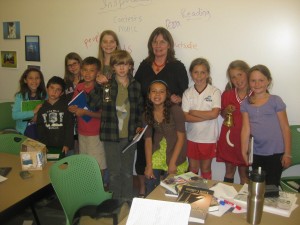“Whatever you can do or believe you can do, begin it; boldness has genius, power — and magic — in it!” — Goethe
At the invitation of Sarah Kostin I met with the Young Writers of Steamboat Springs at the Bud Werner Memorial Library last evening to talk with them about being an author. The theme of my talk and the workshop was Inspiration. I shared the story of how I sailed aboard the Endeavour replica and how we voyage crew members learned how to climb the ratlines and go out on the foot-ropes to make and furl sail; how we learned to steer by the compass and navigate using a sextant. How we took our turns on watch and slept in hammocks we strung on the deck head. How we had to scrub the deck and perform other humble tasks.
“Wait — you mean you weren’t a passenger but you actually had to work?” asked one girl, in disbelief.
“Yes, but that’s what we signed up for. To learn what it was like to be an 18th century sailor; to learn the basics of seamanship in the age of sail. Actually, it was fun. Sort of like Adventure Club for adults.”
I went on to explain how we sailed across the northern Pacific Ocean from Vancouver to Hawaii, and that it took twenty days.
“How did you know where you were?” asked one astute young lad, about eight or nine years old.
I showed him a chart and explained briefly (and inadequately) about sextants are used in celestial navigation.
“Yes, but how?” he pressed.
When pressed by the child for a better explanation, I found myself blathering and dithering and saw all of their faces glaze over at once, like a dark cloud of confusion had passed overhead. Ye gads! Leave it to a child to find your weak spot…
“I bet Captain Cook would have liked to have had GPS,” the boy said.
“Hey, wait!” said another. “Was Captain Cook real? I thought he was a Disney character.”
“You’re thinking of Captain Hook, not Captain Cook. Captain James Cook was very real, and so was his ship. And my character, Patricia MacPherson, was made up, by me. But she might have been real. She could have been real.”
We moved on to the method of time-keeping aboard an 18th century sailing ship. I brought along a 30 minute sand glass and a brass ship’s bell which I let them take turns ringing. One ring on the half hour, two rings on the hour, three, and so fourth until eight bells signified four hours had passed and time for the watch on deck to go below and get some rest.”
“That bell sure is loud,” someone remarked.
“That’s so you could hear it all over the ship,” a clever girl explained.
“Exactly so!” I said, pleased that the ship was beginning to come alive for them now as it had for me.
We shared ideas of what inspires us — and I was inspired by how they enjoyed playing with words and letting their imaginations out of the cage. I’m going to draw on that energy and delve back into my own writing with the boldness of youth. And I am going to brush up on celestial navigation so that the next time a kid asks me I can give them a better explanation!
